NRSG366: Clinical Reasoning Cycle and Jenny Peterson Case Study
VerifiedAdded on 2023/01/11
|7
|2699
|94
Case Study
AI Summary
This assignment analyzes the case of Jenny Peterson, a 23-year-old single mother experiencing seizures, epilepsy, and related mental and physical distress. The analysis employs the Clinical Reasoning Cycle (CRC) to identify and prioritize two key nursing interventions. The first priority focuses on addressing Jenny's mental health, including depression and stress, by exploring alternative therapies and counselling to improve her mental state. The second priority addresses the side effects of her medication (lamotrigine and valproate), such as gastrointestinal issues, and the need for a lower dosage to manage her epilepsy. The assignment details the steps of the CRC, from assessing Jenny's condition to establishing goals, developing action plans, and evaluating the effectiveness of the interventions over a four-week period. The student reflects on the importance of linking patient symptoms, both primary and secondary, to the application of patient priorities to provide effective interventions.
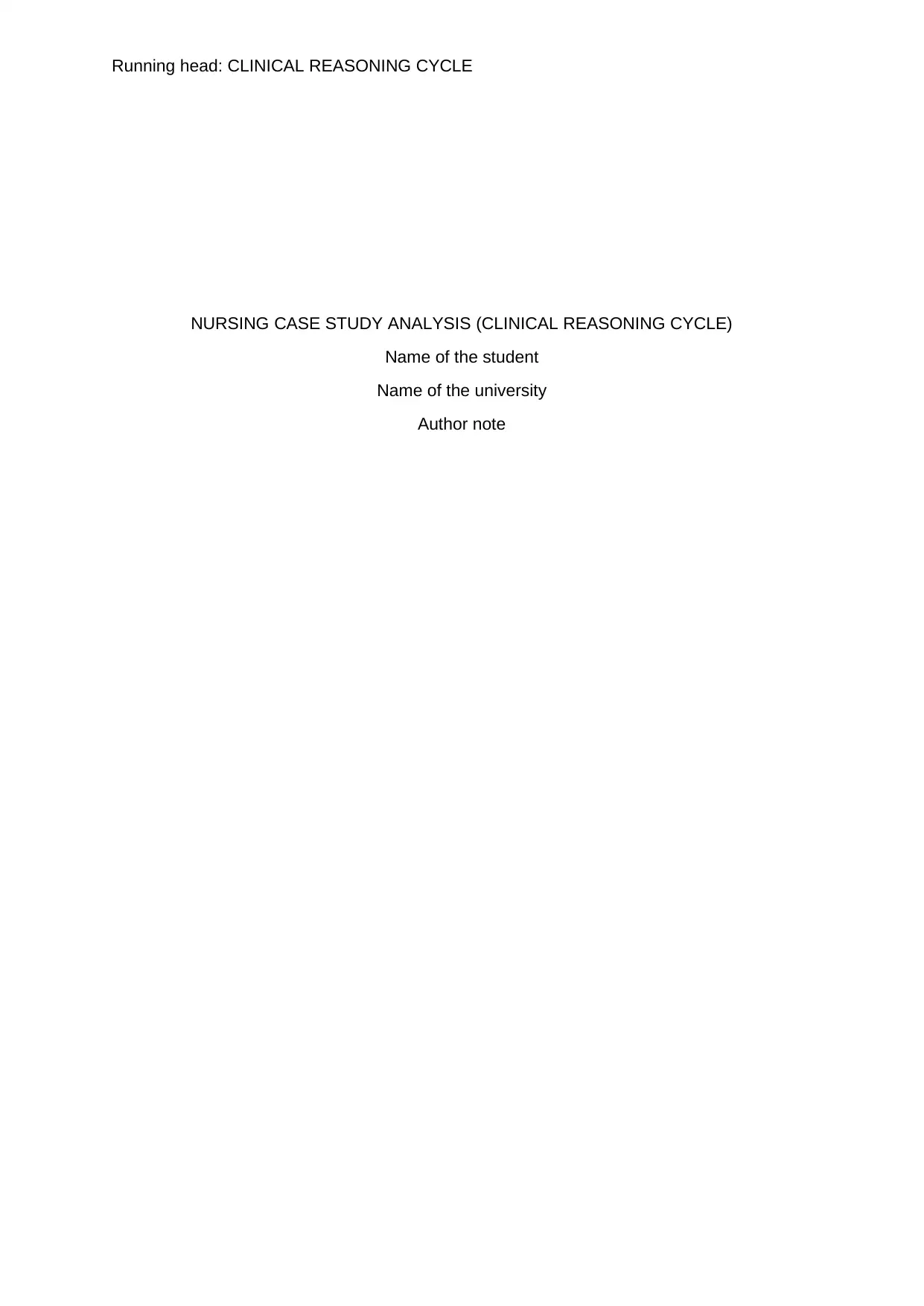
Running head: CLINICAL REASONING CYCLE
NURSING CASE STUDY ANALYSIS (CLINICAL REASONING CYCLE)
Name of the student
Name of the university
Author note
NURSING CASE STUDY ANALYSIS (CLINICAL REASONING CYCLE)
Name of the student
Name of the university
Author note
Paraphrase This Document
Need a fresh take? Get an instant paraphrase of this document with our AI Paraphraser
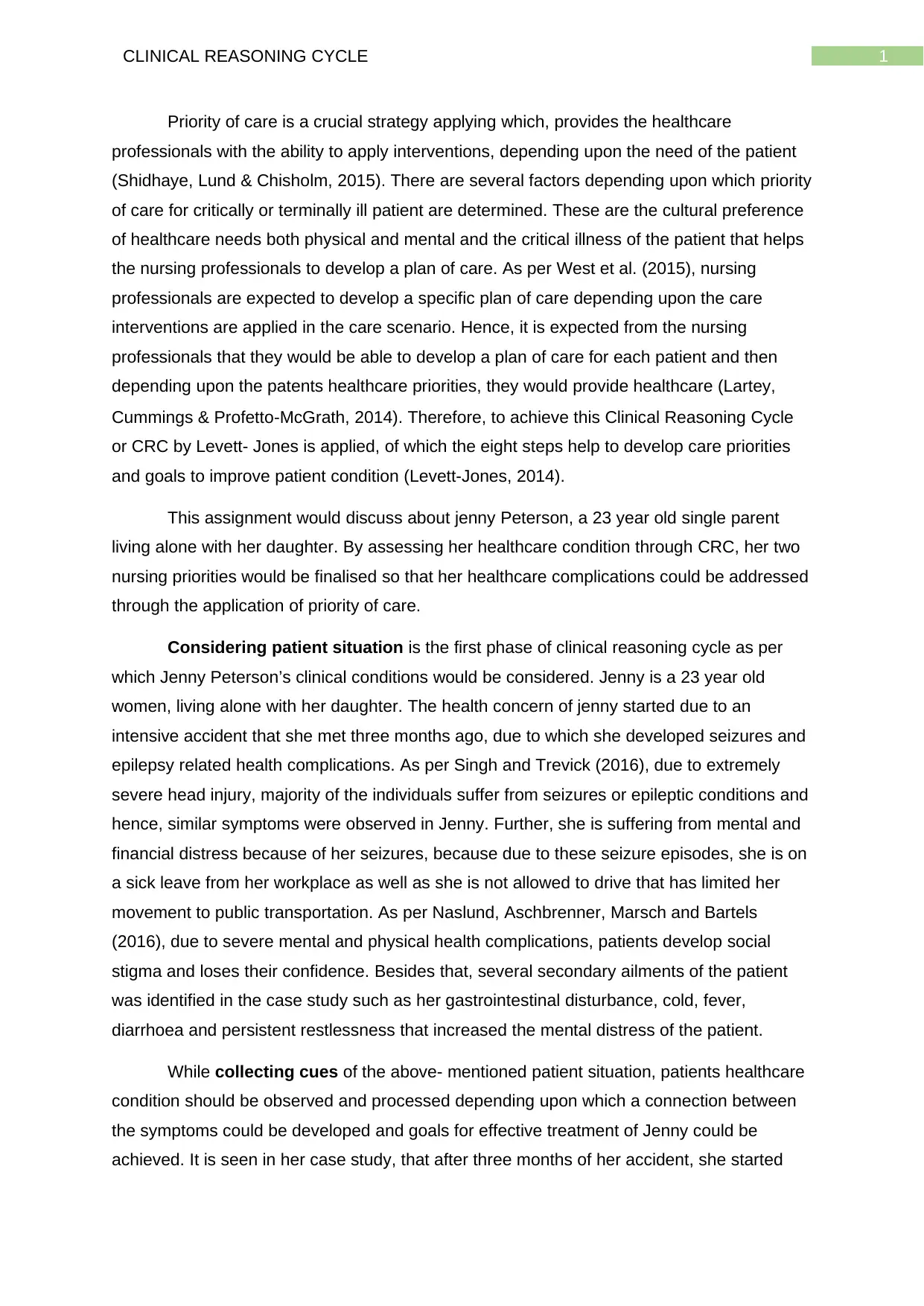
1CLINICAL REASONING CYCLE
Priority of care is a crucial strategy applying which, provides the healthcare
professionals with the ability to apply interventions, depending upon the need of the patient
(Shidhaye, Lund & Chisholm, 2015). There are several factors depending upon which priority
of care for critically or terminally ill patient are determined. These are the cultural preference
of healthcare needs both physical and mental and the critical illness of the patient that helps
the nursing professionals to develop a plan of care. As per West et al. (2015), nursing
professionals are expected to develop a specific plan of care depending upon the care
interventions are applied in the care scenario. Hence, it is expected from the nursing
professionals that they would be able to develop a plan of care for each patient and then
depending upon the patents healthcare priorities, they would provide healthcare (Lartey,
Cummings & Profetto‐McGrath, 2014). Therefore, to achieve this Clinical Reasoning Cycle
or CRC by Levett- Jones is applied, of which the eight steps help to develop care priorities
and goals to improve patient condition (Levett-Jones, 2014).
This assignment would discuss about jenny Peterson, a 23 year old single parent
living alone with her daughter. By assessing her healthcare condition through CRC, her two
nursing priorities would be finalised so that her healthcare complications could be addressed
through the application of priority of care.
Considering patient situation is the first phase of clinical reasoning cycle as per
which Jenny Peterson’s clinical conditions would be considered. Jenny is a 23 year old
women, living alone with her daughter. The health concern of jenny started due to an
intensive accident that she met three months ago, due to which she developed seizures and
epilepsy related health complications. As per Singh and Trevick (2016), due to extremely
severe head injury, majority of the individuals suffer from seizures or epileptic conditions and
hence, similar symptoms were observed in Jenny. Further, she is suffering from mental and
financial distress because of her seizures, because due to these seizure episodes, she is on
a sick leave from her workplace as well as she is not allowed to drive that has limited her
movement to public transportation. As per Naslund, Aschbrenner, Marsch and Bartels
(2016), due to severe mental and physical health complications, patients develop social
stigma and loses their confidence. Besides that, several secondary ailments of the patient
was identified in the case study such as her gastrointestinal disturbance, cold, fever,
diarrhoea and persistent restlessness that increased the mental distress of the patient.
While collecting cues of the above- mentioned patient situation, patients healthcare
condition should be observed and processed depending upon which a connection between
the symptoms could be developed and goals for effective treatment of Jenny could be
achieved. It is seen in her case study, that after three months of her accident, she started
Priority of care is a crucial strategy applying which, provides the healthcare
professionals with the ability to apply interventions, depending upon the need of the patient
(Shidhaye, Lund & Chisholm, 2015). There are several factors depending upon which priority
of care for critically or terminally ill patient are determined. These are the cultural preference
of healthcare needs both physical and mental and the critical illness of the patient that helps
the nursing professionals to develop a plan of care. As per West et al. (2015), nursing
professionals are expected to develop a specific plan of care depending upon the care
interventions are applied in the care scenario. Hence, it is expected from the nursing
professionals that they would be able to develop a plan of care for each patient and then
depending upon the patents healthcare priorities, they would provide healthcare (Lartey,
Cummings & Profetto‐McGrath, 2014). Therefore, to achieve this Clinical Reasoning Cycle
or CRC by Levett- Jones is applied, of which the eight steps help to develop care priorities
and goals to improve patient condition (Levett-Jones, 2014).
This assignment would discuss about jenny Peterson, a 23 year old single parent
living alone with her daughter. By assessing her healthcare condition through CRC, her two
nursing priorities would be finalised so that her healthcare complications could be addressed
through the application of priority of care.
Considering patient situation is the first phase of clinical reasoning cycle as per
which Jenny Peterson’s clinical conditions would be considered. Jenny is a 23 year old
women, living alone with her daughter. The health concern of jenny started due to an
intensive accident that she met three months ago, due to which she developed seizures and
epilepsy related health complications. As per Singh and Trevick (2016), due to extremely
severe head injury, majority of the individuals suffer from seizures or epileptic conditions and
hence, similar symptoms were observed in Jenny. Further, she is suffering from mental and
financial distress because of her seizures, because due to these seizure episodes, she is on
a sick leave from her workplace as well as she is not allowed to drive that has limited her
movement to public transportation. As per Naslund, Aschbrenner, Marsch and Bartels
(2016), due to severe mental and physical health complications, patients develop social
stigma and loses their confidence. Besides that, several secondary ailments of the patient
was identified in the case study such as her gastrointestinal disturbance, cold, fever,
diarrhoea and persistent restlessness that increased the mental distress of the patient.
While collecting cues of the above- mentioned patient situation, patients healthcare
condition should be observed and processed depending upon which a connection between
the symptoms could be developed and goals for effective treatment of Jenny could be
achieved. It is seen in her case study, that after three months of her accident, she started
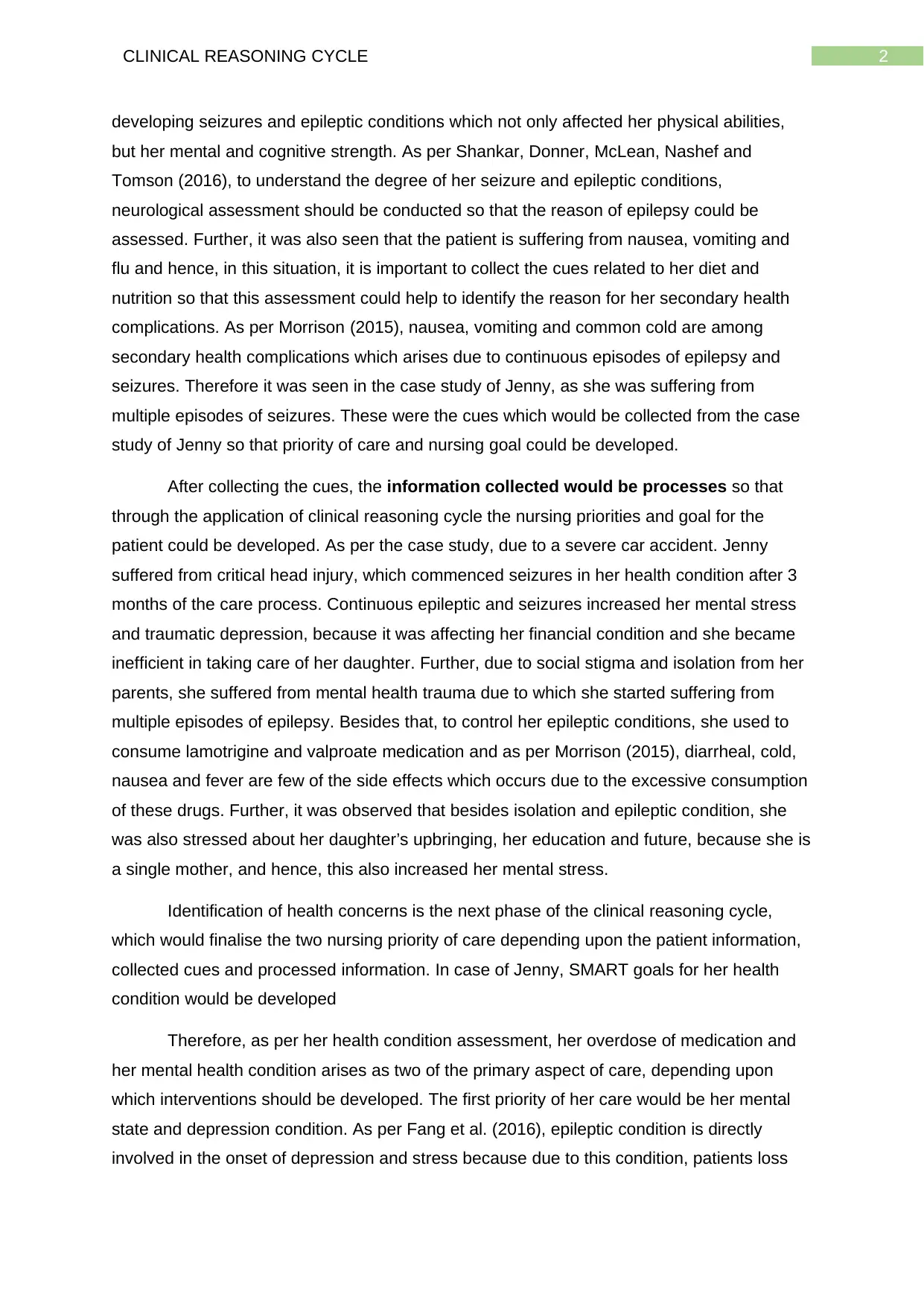
2CLINICAL REASONING CYCLE
developing seizures and epileptic conditions which not only affected her physical abilities,
but her mental and cognitive strength. As per Shankar, Donner, McLean, Nashef and
Tomson (2016), to understand the degree of her seizure and epileptic conditions,
neurological assessment should be conducted so that the reason of epilepsy could be
assessed. Further, it was also seen that the patient is suffering from nausea, vomiting and
flu and hence, in this situation, it is important to collect the cues related to her diet and
nutrition so that this assessment could help to identify the reason for her secondary health
complications. As per Morrison (2015), nausea, vomiting and common cold are among
secondary health complications which arises due to continuous episodes of epilepsy and
seizures. Therefore it was seen in the case study of Jenny, as she was suffering from
multiple episodes of seizures. These were the cues which would be collected from the case
study of Jenny so that priority of care and nursing goal could be developed.
After collecting the cues, the information collected would be processes so that
through the application of clinical reasoning cycle the nursing priorities and goal for the
patient could be developed. As per the case study, due to a severe car accident. Jenny
suffered from critical head injury, which commenced seizures in her health condition after 3
months of the care process. Continuous epileptic and seizures increased her mental stress
and traumatic depression, because it was affecting her financial condition and she became
inefficient in taking care of her daughter. Further, due to social stigma and isolation from her
parents, she suffered from mental health trauma due to which she started suffering from
multiple episodes of epilepsy. Besides that, to control her epileptic conditions, she used to
consume lamotrigine and valproate medication and as per Morrison (2015), diarrheal, cold,
nausea and fever are few of the side effects which occurs due to the excessive consumption
of these drugs. Further, it was observed that besides isolation and epileptic condition, she
was also stressed about her daughter’s upbringing, her education and future, because she is
a single mother, and hence, this also increased her mental stress.
Identification of health concerns is the next phase of the clinical reasoning cycle,
which would finalise the two nursing priority of care depending upon the patient information,
collected cues and processed information. In case of Jenny, SMART goals for her health
condition would be developed
Therefore, as per her health condition assessment, her overdose of medication and
her mental health condition arises as two of the primary aspect of care, depending upon
which interventions should be developed. The first priority of her care would be her mental
state and depression condition. As per Fang et al. (2016), epileptic condition is directly
involved in the onset of depression and stress because due to this condition, patients loss
developing seizures and epileptic conditions which not only affected her physical abilities,
but her mental and cognitive strength. As per Shankar, Donner, McLean, Nashef and
Tomson (2016), to understand the degree of her seizure and epileptic conditions,
neurological assessment should be conducted so that the reason of epilepsy could be
assessed. Further, it was also seen that the patient is suffering from nausea, vomiting and
flu and hence, in this situation, it is important to collect the cues related to her diet and
nutrition so that this assessment could help to identify the reason for her secondary health
complications. As per Morrison (2015), nausea, vomiting and common cold are among
secondary health complications which arises due to continuous episodes of epilepsy and
seizures. Therefore it was seen in the case study of Jenny, as she was suffering from
multiple episodes of seizures. These were the cues which would be collected from the case
study of Jenny so that priority of care and nursing goal could be developed.
After collecting the cues, the information collected would be processes so that
through the application of clinical reasoning cycle the nursing priorities and goal for the
patient could be developed. As per the case study, due to a severe car accident. Jenny
suffered from critical head injury, which commenced seizures in her health condition after 3
months of the care process. Continuous epileptic and seizures increased her mental stress
and traumatic depression, because it was affecting her financial condition and she became
inefficient in taking care of her daughter. Further, due to social stigma and isolation from her
parents, she suffered from mental health trauma due to which she started suffering from
multiple episodes of epilepsy. Besides that, to control her epileptic conditions, she used to
consume lamotrigine and valproate medication and as per Morrison (2015), diarrheal, cold,
nausea and fever are few of the side effects which occurs due to the excessive consumption
of these drugs. Further, it was observed that besides isolation and epileptic condition, she
was also stressed about her daughter’s upbringing, her education and future, because she is
a single mother, and hence, this also increased her mental stress.
Identification of health concerns is the next phase of the clinical reasoning cycle,
which would finalise the two nursing priority of care depending upon the patient information,
collected cues and processed information. In case of Jenny, SMART goals for her health
condition would be developed
Therefore, as per her health condition assessment, her overdose of medication and
her mental health condition arises as two of the primary aspect of care, depending upon
which interventions should be developed. The first priority of her care would be her mental
state and depression condition. As per Fang et al. (2016), epileptic condition is directly
involved in the onset of depression and stress because due to this condition, patients loss
⊘ This is a preview!⊘
Do you want full access?
Subscribe today to unlock all pages.

Trusted by 1+ million students worldwide
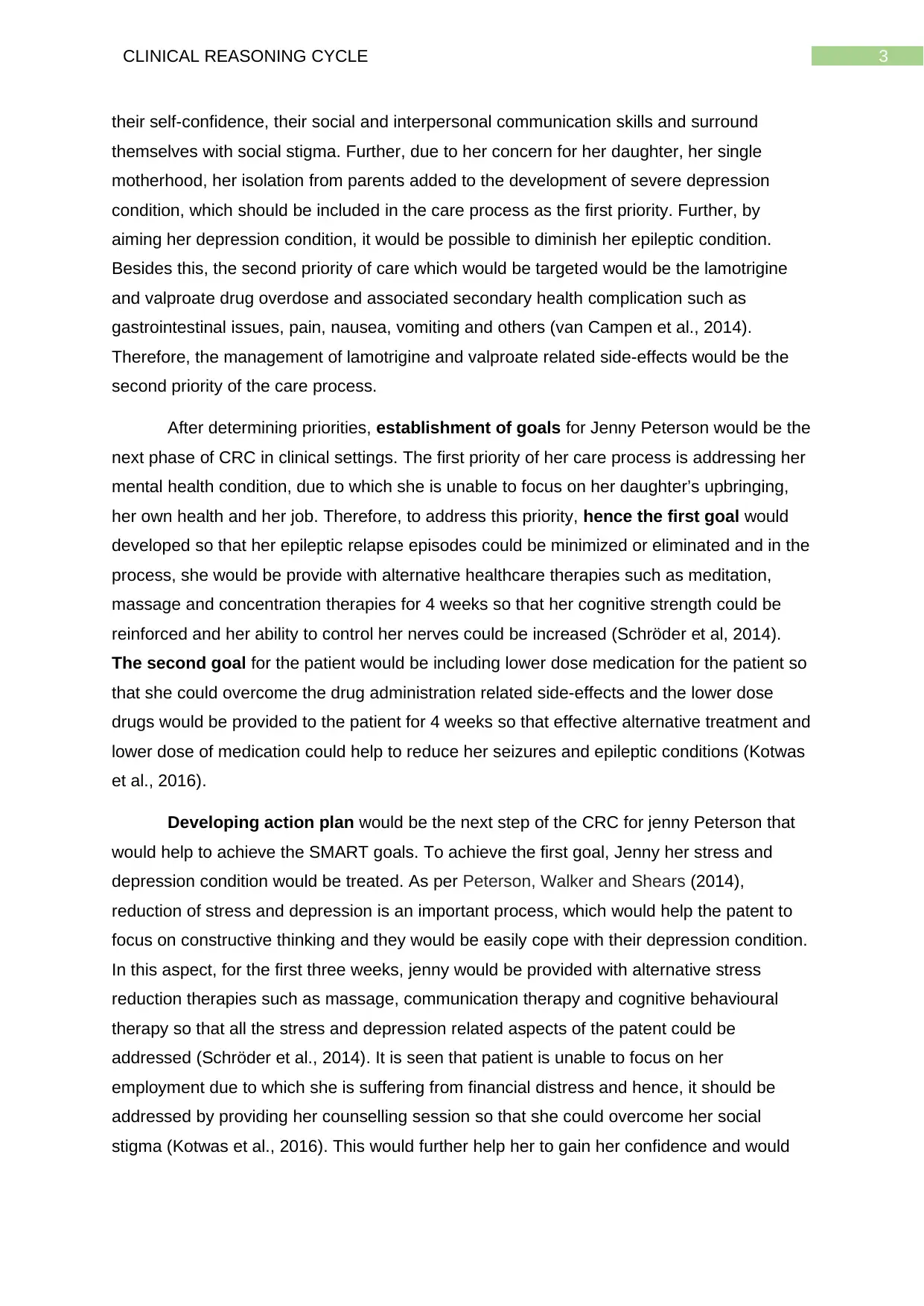
3CLINICAL REASONING CYCLE
their self-confidence, their social and interpersonal communication skills and surround
themselves with social stigma. Further, due to her concern for her daughter, her single
motherhood, her isolation from parents added to the development of severe depression
condition, which should be included in the care process as the first priority. Further, by
aiming her depression condition, it would be possible to diminish her epileptic condition.
Besides this, the second priority of care which would be targeted would be the lamotrigine
and valproate drug overdose and associated secondary health complication such as
gastrointestinal issues, pain, nausea, vomiting and others (van Campen et al., 2014).
Therefore, the management of lamotrigine and valproate related side-effects would be the
second priority of the care process.
After determining priorities, establishment of goals for Jenny Peterson would be the
next phase of CRC in clinical settings. The first priority of her care process is addressing her
mental health condition, due to which she is unable to focus on her daughter’s upbringing,
her own health and her job. Therefore, to address this priority, hence the first goal would
developed so that her epileptic relapse episodes could be minimized or eliminated and in the
process, she would be provide with alternative healthcare therapies such as meditation,
massage and concentration therapies for 4 weeks so that her cognitive strength could be
reinforced and her ability to control her nerves could be increased (Schröder et al, 2014).
The second goal for the patient would be including lower dose medication for the patient so
that she could overcome the drug administration related side-effects and the lower dose
drugs would be provided to the patient for 4 weeks so that effective alternative treatment and
lower dose of medication could help to reduce her seizures and epileptic conditions (Kotwas
et al., 2016).
Developing action plan would be the next step of the CRC for jenny Peterson that
would help to achieve the SMART goals. To achieve the first goal, Jenny her stress and
depression condition would be treated. As per Peterson, Walker and Shears (2014),
reduction of stress and depression is an important process, which would help the patent to
focus on constructive thinking and they would be easily cope with their depression condition.
In this aspect, for the first three weeks, jenny would be provided with alternative stress
reduction therapies such as massage, communication therapy and cognitive behavioural
therapy so that all the stress and depression related aspects of the patent could be
addressed (Schröder et al., 2014). It is seen that patient is unable to focus on her
employment due to which she is suffering from financial distress and hence, it should be
addressed by providing her counselling session so that she could overcome her social
stigma (Kotwas et al., 2016). This would further help her to gain her confidence and would
their self-confidence, their social and interpersonal communication skills and surround
themselves with social stigma. Further, due to her concern for her daughter, her single
motherhood, her isolation from parents added to the development of severe depression
condition, which should be included in the care process as the first priority. Further, by
aiming her depression condition, it would be possible to diminish her epileptic condition.
Besides this, the second priority of care which would be targeted would be the lamotrigine
and valproate drug overdose and associated secondary health complication such as
gastrointestinal issues, pain, nausea, vomiting and others (van Campen et al., 2014).
Therefore, the management of lamotrigine and valproate related side-effects would be the
second priority of the care process.
After determining priorities, establishment of goals for Jenny Peterson would be the
next phase of CRC in clinical settings. The first priority of her care process is addressing her
mental health condition, due to which she is unable to focus on her daughter’s upbringing,
her own health and her job. Therefore, to address this priority, hence the first goal would
developed so that her epileptic relapse episodes could be minimized or eliminated and in the
process, she would be provide with alternative healthcare therapies such as meditation,
massage and concentration therapies for 4 weeks so that her cognitive strength could be
reinforced and her ability to control her nerves could be increased (Schröder et al, 2014).
The second goal for the patient would be including lower dose medication for the patient so
that she could overcome the drug administration related side-effects and the lower dose
drugs would be provided to the patient for 4 weeks so that effective alternative treatment and
lower dose of medication could help to reduce her seizures and epileptic conditions (Kotwas
et al., 2016).
Developing action plan would be the next step of the CRC for jenny Peterson that
would help to achieve the SMART goals. To achieve the first goal, Jenny her stress and
depression condition would be treated. As per Peterson, Walker and Shears (2014),
reduction of stress and depression is an important process, which would help the patent to
focus on constructive thinking and they would be easily cope with their depression condition.
In this aspect, for the first three weeks, jenny would be provided with alternative stress
reduction therapies such as massage, communication therapy and cognitive behavioural
therapy so that all the stress and depression related aspects of the patent could be
addressed (Schröder et al., 2014). It is seen that patient is unable to focus on her
employment due to which she is suffering from financial distress and hence, it should be
addressed by providing her counselling session so that she could overcome her social
stigma (Kotwas et al., 2016). This would further help her to gain her confidence and would
Paraphrase This Document
Need a fresh take? Get an instant paraphrase of this document with our AI Paraphraser
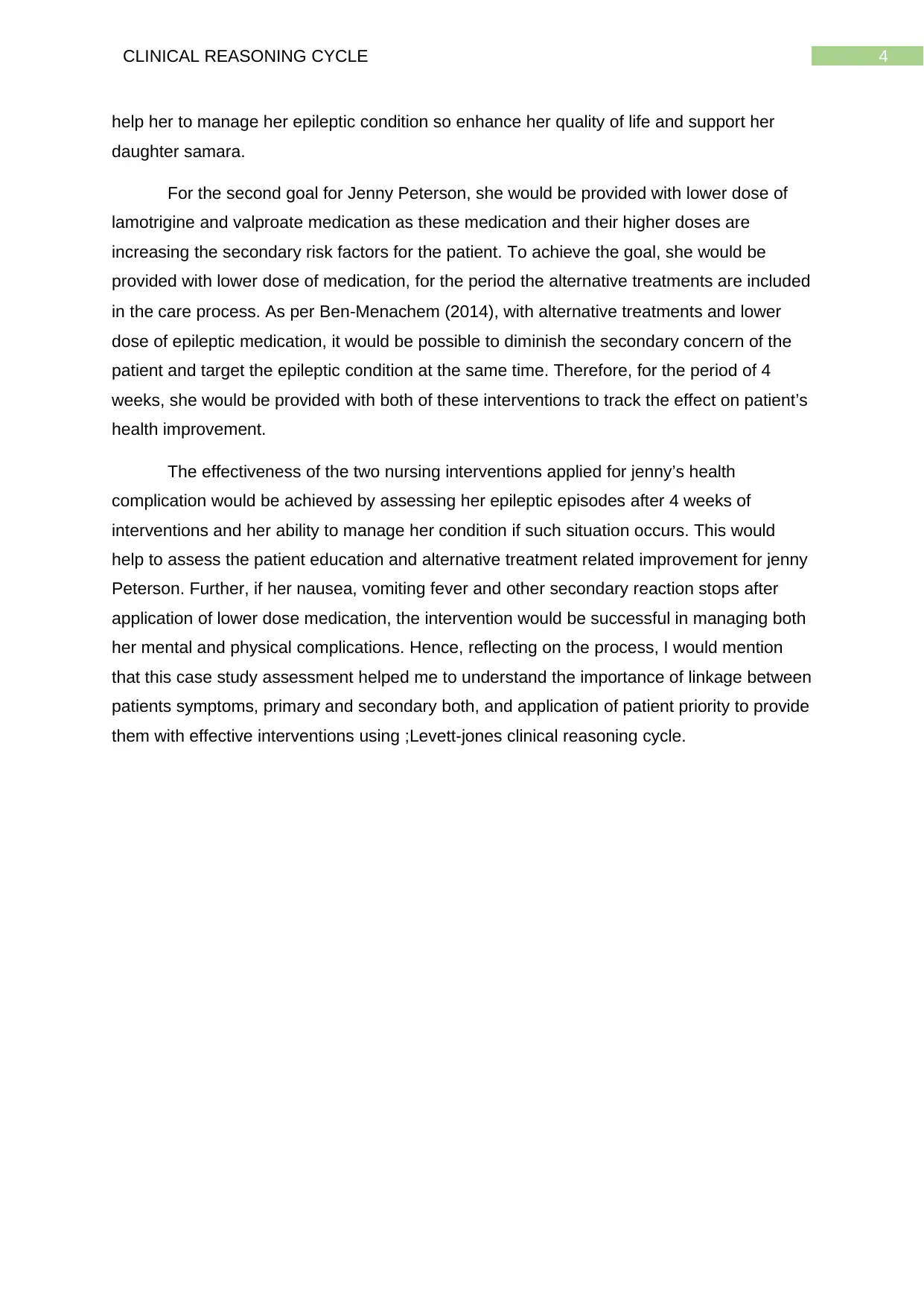
4CLINICAL REASONING CYCLE
help her to manage her epileptic condition so enhance her quality of life and support her
daughter samara.
For the second goal for Jenny Peterson, she would be provided with lower dose of
lamotrigine and valproate medication as these medication and their higher doses are
increasing the secondary risk factors for the patient. To achieve the goal, she would be
provided with lower dose of medication, for the period the alternative treatments are included
in the care process. As per Ben‐Menachem (2014), with alternative treatments and lower
dose of epileptic medication, it would be possible to diminish the secondary concern of the
patient and target the epileptic condition at the same time. Therefore, for the period of 4
weeks, she would be provided with both of these interventions to track the effect on patient’s
health improvement.
The effectiveness of the two nursing interventions applied for jenny’s health
complication would be achieved by assessing her epileptic episodes after 4 weeks of
interventions and her ability to manage her condition if such situation occurs. This would
help to assess the patient education and alternative treatment related improvement for jenny
Peterson. Further, if her nausea, vomiting fever and other secondary reaction stops after
application of lower dose medication, the intervention would be successful in managing both
her mental and physical complications. Hence, reflecting on the process, I would mention
that this case study assessment helped me to understand the importance of linkage between
patients symptoms, primary and secondary both, and application of patient priority to provide
them with effective interventions using ;Levett-jones clinical reasoning cycle.
help her to manage her epileptic condition so enhance her quality of life and support her
daughter samara.
For the second goal for Jenny Peterson, she would be provided with lower dose of
lamotrigine and valproate medication as these medication and their higher doses are
increasing the secondary risk factors for the patient. To achieve the goal, she would be
provided with lower dose of medication, for the period the alternative treatments are included
in the care process. As per Ben‐Menachem (2014), with alternative treatments and lower
dose of epileptic medication, it would be possible to diminish the secondary concern of the
patient and target the epileptic condition at the same time. Therefore, for the period of 4
weeks, she would be provided with both of these interventions to track the effect on patient’s
health improvement.
The effectiveness of the two nursing interventions applied for jenny’s health
complication would be achieved by assessing her epileptic episodes after 4 weeks of
interventions and her ability to manage her condition if such situation occurs. This would
help to assess the patient education and alternative treatment related improvement for jenny
Peterson. Further, if her nausea, vomiting fever and other secondary reaction stops after
application of lower dose medication, the intervention would be successful in managing both
her mental and physical complications. Hence, reflecting on the process, I would mention
that this case study assessment helped me to understand the importance of linkage between
patients symptoms, primary and secondary both, and application of patient priority to provide
them with effective interventions using ;Levett-jones clinical reasoning cycle.
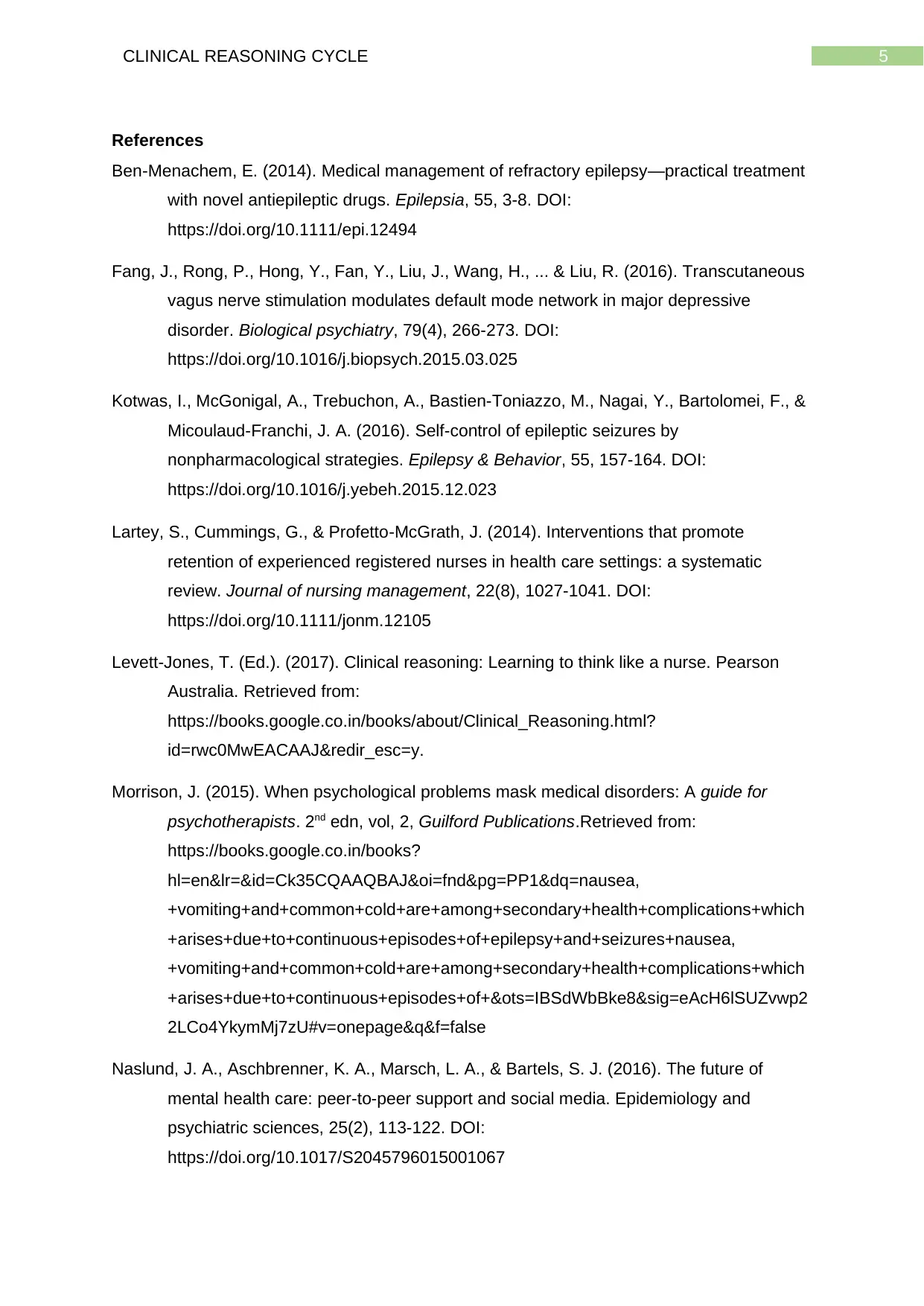
5CLINICAL REASONING CYCLE
References
Ben‐Menachem, E. (2014). Medical management of refractory epilepsy—practical treatment
with novel antiepileptic drugs. Epilepsia, 55, 3-8. DOI:
https://doi.org/10.1111/epi.12494
Fang, J., Rong, P., Hong, Y., Fan, Y., Liu, J., Wang, H., ... & Liu, R. (2016). Transcutaneous
vagus nerve stimulation modulates default mode network in major depressive
disorder. Biological psychiatry, 79(4), 266-273. DOI:
https://doi.org/10.1016/j.biopsych.2015.03.025
Kotwas, I., McGonigal, A., Trebuchon, A., Bastien-Toniazzo, M., Nagai, Y., Bartolomei, F., &
Micoulaud-Franchi, J. A. (2016). Self-control of epileptic seizures by
nonpharmacological strategies. Epilepsy & Behavior, 55, 157-164. DOI:
https://doi.org/10.1016/j.yebeh.2015.12.023
Lartey, S., Cummings, G., & Profetto‐McGrath, J. (2014). Interventions that promote
retention of experienced registered nurses in health care settings: a systematic
review. Journal of nursing management, 22(8), 1027-1041. DOI:
https://doi.org/10.1111/jonm.12105
Levett-Jones, T. (Ed.). (2017). Clinical reasoning: Learning to think like a nurse. Pearson
Australia. Retrieved from:
https://books.google.co.in/books/about/Clinical_Reasoning.html?
id=rwc0MwEACAAJ&redir_esc=y.
Morrison, J. (2015). When psychological problems mask medical disorders: A guide for
psychotherapists. 2nd edn, vol, 2, Guilford Publications.Retrieved from:
https://books.google.co.in/books?
hl=en&lr=&id=Ck35CQAAQBAJ&oi=fnd&pg=PP1&dq=nausea,
+vomiting+and+common+cold+are+among+secondary+health+complications+which
+arises+due+to+continuous+episodes+of+epilepsy+and+seizures+nausea,
+vomiting+and+common+cold+are+among+secondary+health+complications+which
+arises+due+to+continuous+episodes+of+&ots=IBSdWbBke8&sig=eAcH6lSUZvwp2
2LCo4YkymMj7zU#v=onepage&q&f=false
Naslund, J. A., Aschbrenner, K. A., Marsch, L. A., & Bartels, S. J. (2016). The future of
mental health care: peer-to-peer support and social media. Epidemiology and
psychiatric sciences, 25(2), 113-122. DOI:
https://doi.org/10.1017/S2045796015001067
References
Ben‐Menachem, E. (2014). Medical management of refractory epilepsy—practical treatment
with novel antiepileptic drugs. Epilepsia, 55, 3-8. DOI:
https://doi.org/10.1111/epi.12494
Fang, J., Rong, P., Hong, Y., Fan, Y., Liu, J., Wang, H., ... & Liu, R. (2016). Transcutaneous
vagus nerve stimulation modulates default mode network in major depressive
disorder. Biological psychiatry, 79(4), 266-273. DOI:
https://doi.org/10.1016/j.biopsych.2015.03.025
Kotwas, I., McGonigal, A., Trebuchon, A., Bastien-Toniazzo, M., Nagai, Y., Bartolomei, F., &
Micoulaud-Franchi, J. A. (2016). Self-control of epileptic seizures by
nonpharmacological strategies. Epilepsy & Behavior, 55, 157-164. DOI:
https://doi.org/10.1016/j.yebeh.2015.12.023
Lartey, S., Cummings, G., & Profetto‐McGrath, J. (2014). Interventions that promote
retention of experienced registered nurses in health care settings: a systematic
review. Journal of nursing management, 22(8), 1027-1041. DOI:
https://doi.org/10.1111/jonm.12105
Levett-Jones, T. (Ed.). (2017). Clinical reasoning: Learning to think like a nurse. Pearson
Australia. Retrieved from:
https://books.google.co.in/books/about/Clinical_Reasoning.html?
id=rwc0MwEACAAJ&redir_esc=y.
Morrison, J. (2015). When psychological problems mask medical disorders: A guide for
psychotherapists. 2nd edn, vol, 2, Guilford Publications.Retrieved from:
https://books.google.co.in/books?
hl=en&lr=&id=Ck35CQAAQBAJ&oi=fnd&pg=PP1&dq=nausea,
+vomiting+and+common+cold+are+among+secondary+health+complications+which
+arises+due+to+continuous+episodes+of+epilepsy+and+seizures+nausea,
+vomiting+and+common+cold+are+among+secondary+health+complications+which
+arises+due+to+continuous+episodes+of+&ots=IBSdWbBke8&sig=eAcH6lSUZvwp2
2LCo4YkymMj7zU#v=onepage&q&f=false
Naslund, J. A., Aschbrenner, K. A., Marsch, L. A., & Bartels, S. J. (2016). The future of
mental health care: peer-to-peer support and social media. Epidemiology and
psychiatric sciences, 25(2), 113-122. DOI:
https://doi.org/10.1017/S2045796015001067
⊘ This is a preview!⊘
Do you want full access?
Subscribe today to unlock all pages.

Trusted by 1+ million students worldwide
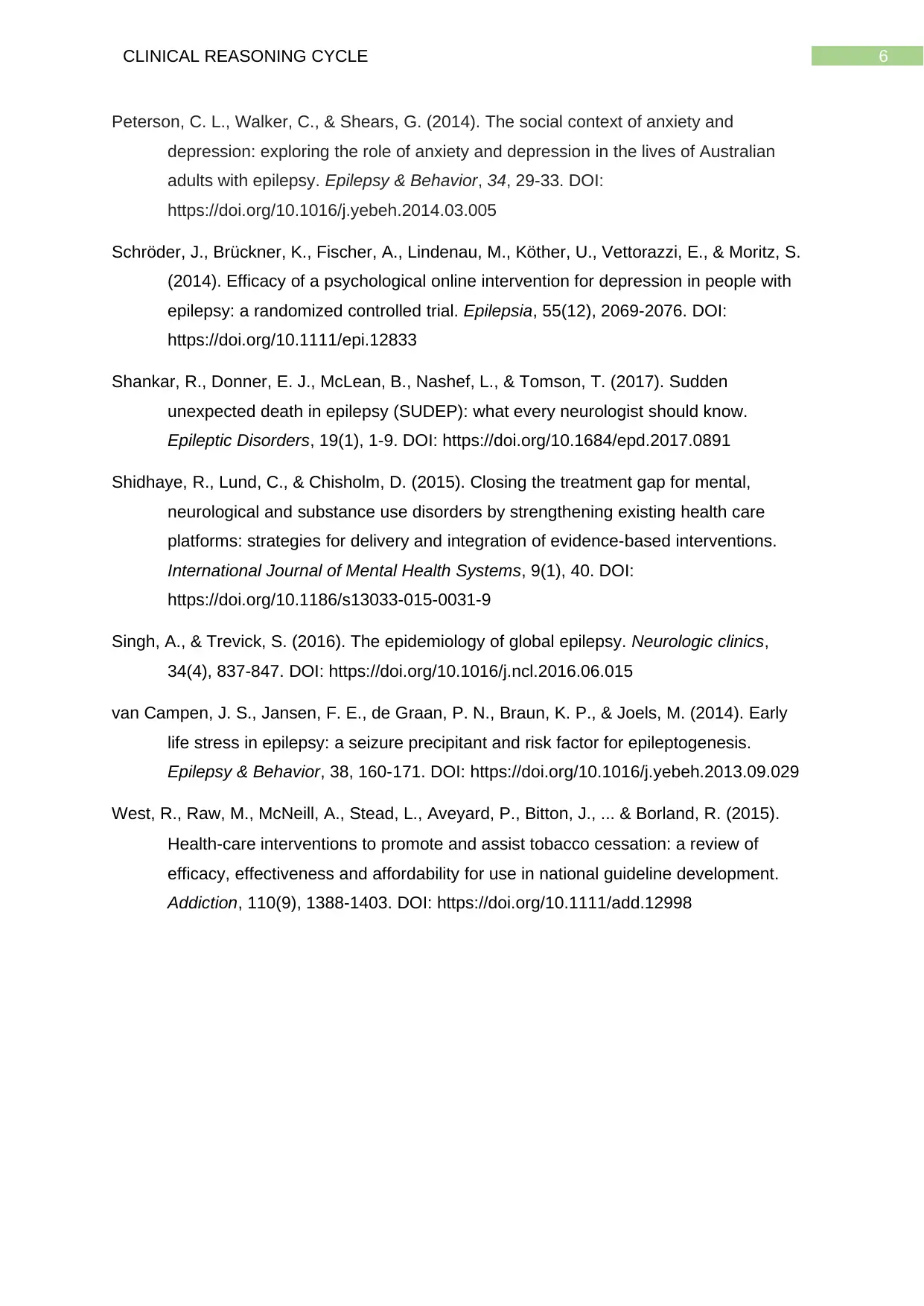
6CLINICAL REASONING CYCLE
Peterson, C. L., Walker, C., & Shears, G. (2014). The social context of anxiety and
depression: exploring the role of anxiety and depression in the lives of Australian
adults with epilepsy. Epilepsy & Behavior, 34, 29-33. DOI:
https://doi.org/10.1016/j.yebeh.2014.03.005
Schröder, J., Brückner, K., Fischer, A., Lindenau, M., Köther, U., Vettorazzi, E., & Moritz, S.
(2014). Efficacy of a psychological online intervention for depression in people with
epilepsy: a randomized controlled trial. Epilepsia, 55(12), 2069-2076. DOI:
https://doi.org/10.1111/epi.12833
Shankar, R., Donner, E. J., McLean, B., Nashef, L., & Tomson, T. (2017). Sudden
unexpected death in epilepsy (SUDEP): what every neurologist should know.
Epileptic Disorders, 19(1), 1-9. DOI: https://doi.org/10.1684/epd.2017.0891
Shidhaye, R., Lund, C., & Chisholm, D. (2015). Closing the treatment gap for mental,
neurological and substance use disorders by strengthening existing health care
platforms: strategies for delivery and integration of evidence-based interventions.
International Journal of Mental Health Systems, 9(1), 40. DOI:
https://doi.org/10.1186/s13033-015-0031-9
Singh, A., & Trevick, S. (2016). The epidemiology of global epilepsy. Neurologic clinics,
34(4), 837-847. DOI: https://doi.org/10.1016/j.ncl.2016.06.015
van Campen, J. S., Jansen, F. E., de Graan, P. N., Braun, K. P., & Joels, M. (2014). Early
life stress in epilepsy: a seizure precipitant and risk factor for epileptogenesis.
Epilepsy & Behavior, 38, 160-171. DOI: https://doi.org/10.1016/j.yebeh.2013.09.029
West, R., Raw, M., McNeill, A., Stead, L., Aveyard, P., Bitton, J., ... & Borland, R. (2015).
Health‐care interventions to promote and assist tobacco cessation: a review of
efficacy, effectiveness and affordability for use in national guideline development.
Addiction, 110(9), 1388-1403. DOI: https://doi.org/10.1111/add.12998
Peterson, C. L., Walker, C., & Shears, G. (2014). The social context of anxiety and
depression: exploring the role of anxiety and depression in the lives of Australian
adults with epilepsy. Epilepsy & Behavior, 34, 29-33. DOI:
https://doi.org/10.1016/j.yebeh.2014.03.005
Schröder, J., Brückner, K., Fischer, A., Lindenau, M., Köther, U., Vettorazzi, E., & Moritz, S.
(2014). Efficacy of a psychological online intervention for depression in people with
epilepsy: a randomized controlled trial. Epilepsia, 55(12), 2069-2076. DOI:
https://doi.org/10.1111/epi.12833
Shankar, R., Donner, E. J., McLean, B., Nashef, L., & Tomson, T. (2017). Sudden
unexpected death in epilepsy (SUDEP): what every neurologist should know.
Epileptic Disorders, 19(1), 1-9. DOI: https://doi.org/10.1684/epd.2017.0891
Shidhaye, R., Lund, C., & Chisholm, D. (2015). Closing the treatment gap for mental,
neurological and substance use disorders by strengthening existing health care
platforms: strategies for delivery and integration of evidence-based interventions.
International Journal of Mental Health Systems, 9(1), 40. DOI:
https://doi.org/10.1186/s13033-015-0031-9
Singh, A., & Trevick, S. (2016). The epidemiology of global epilepsy. Neurologic clinics,
34(4), 837-847. DOI: https://doi.org/10.1016/j.ncl.2016.06.015
van Campen, J. S., Jansen, F. E., de Graan, P. N., Braun, K. P., & Joels, M. (2014). Early
life stress in epilepsy: a seizure precipitant and risk factor for epileptogenesis.
Epilepsy & Behavior, 38, 160-171. DOI: https://doi.org/10.1016/j.yebeh.2013.09.029
West, R., Raw, M., McNeill, A., Stead, L., Aveyard, P., Bitton, J., ... & Borland, R. (2015).
Health‐care interventions to promote and assist tobacco cessation: a review of
efficacy, effectiveness and affordability for use in national guideline development.
Addiction, 110(9), 1388-1403. DOI: https://doi.org/10.1111/add.12998
1 out of 7
Related Documents
Your All-in-One AI-Powered Toolkit for Academic Success.
+13062052269
info@desklib.com
Available 24*7 on WhatsApp / Email
![[object Object]](/_next/static/media/star-bottom.7253800d.svg)
Unlock your academic potential
Copyright © 2020–2025 A2Z Services. All Rights Reserved. Developed and managed by ZUCOL.





